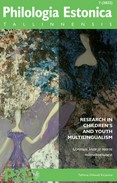THE ENGLISH FRICATIVE CONSONANT /Z/ AS A CHALLENGE TO NORWEGIAN L1 EFL LEARNERS: AN ERROR ANALYSIS OF PHONEMIC TRANSCRIPTIONS
THE ENGLISH FRICATIVE CONSONANT /Z/ AS A CHALLENGE TO NORWEGIAN L1 EFL LEARNERS: AN ERROR ANALYSIS OF PHONEMIC TRANSCRIPTIONS
Author(s): Oleksandr KapranovSubject(s): Foreign languages learning, Phonetics / Phonology, Language acquisition, Comparative Linguistics
Published by: Tallinna Ülikooli Kirjastus
Keywords: English as a Foreign Language (EFL); the English fricative consonant /z/; /s/ – /z/ contrast; upper-intermediate EFL learners; Norwegian L1;
Summary/Abstract: English fricatives, such as /z/, are thought to pose substantial challenges to the students of English as a Foreign Language (EFL) whose first languages (L1s) are characterised by phonetic repertoires that are dissimilar to that of English as far as fricatives are concerned (Kallio et al. 2021; Kanokpermpoon 2007). The absence of the fricative /z/ in the phonetic inventory of Norwegian is reported to impact negatively on the Norwegian L1 EFL learners’ speech production in English (Rugesater 2014). The study that is further presented in the article aims to analyse potential challenges associated with the English fricative consonant /z/ experienced by a group of Norwegian L1 EFL students (hereafter “participants”) on the B2 level of proficiency in English according to the Common European Framework of Reference for Languages (The Council of Europe 2011). To that end, the participants were requested to execute a series of phonemic transcriptions in the International Phonetic Alphabet (IPA): one transcription at the end of the autumn semester (Task 1) and another one at the end of the spring semester (Task 2). The phonemic transcriptions in the study were regarded as a diagnostic tool (Fouz-Gonzalez, Mompean 2021; Lintunen 2005) that provided an index of the participants’ familiarity with /z/ and, indirectly, reflected their use of /z/. The error analysis of the participants’ transcriptions revealed that the majority of them made mistakes by substituting /z/ for /s/. Considering that the substitution of /z/ for /s/ was common in Task 1 and persisted in Task 2, it was concluded that the participants, who were on the upper-intermediate level of English proficiency, found /z/ challenging. The linguo-didactic implications of the findings are discussed in the article.
Journal: Philologia Estonica Tallinnensis
- Issue Year: 7/2022
- Issue No: 1
- Page Range: 148-185
- Page Count: 38
- Language: English

